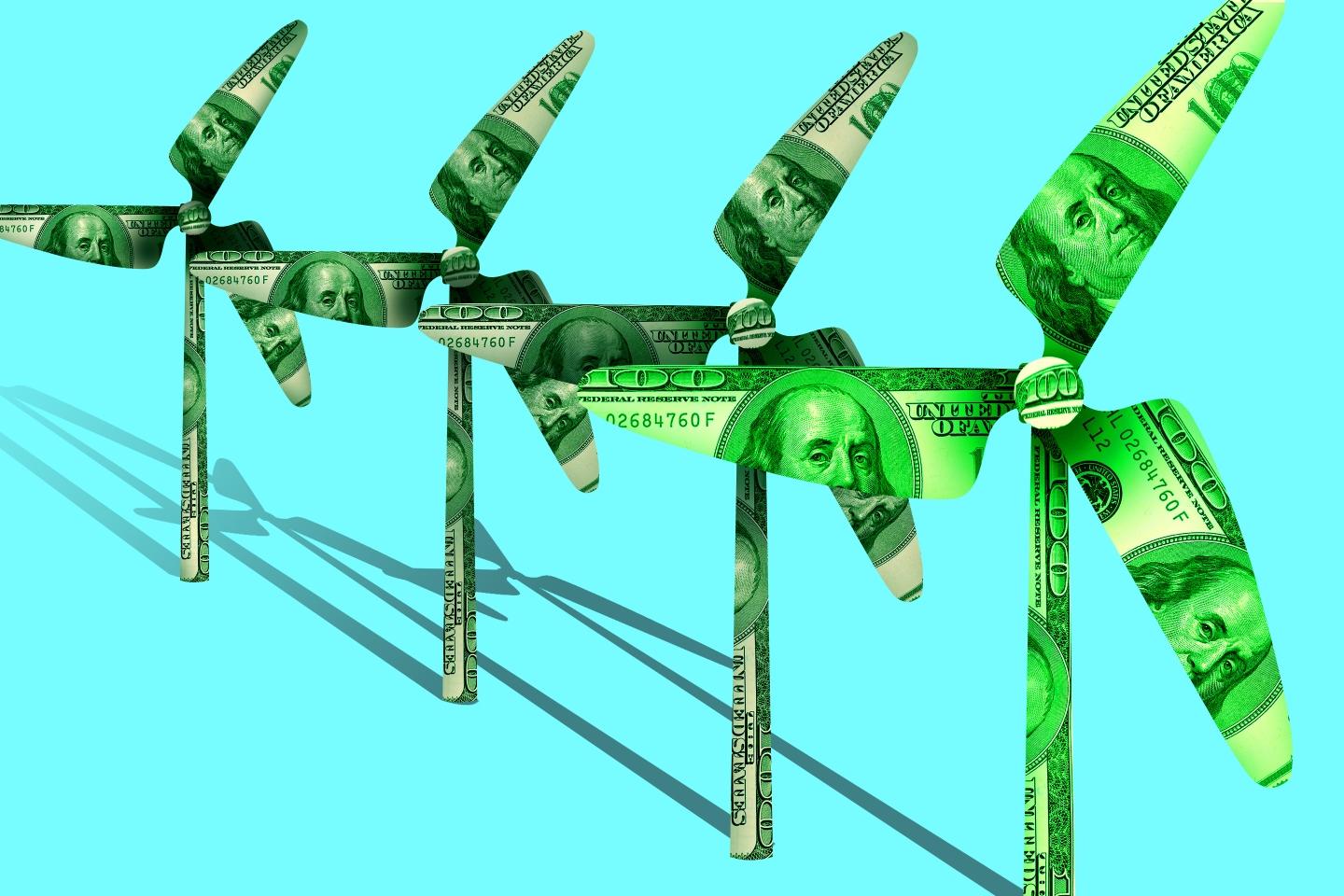Digital payments are a convenient and secure way to conduct transactions. With the rapid advancements in information technology, they have radically influenced the entire FinTech industry. Nowadays, they go hand in hand together with green initiatives as more people are showing awareness and demanding sustainable solutions.
In this piece, we will touch upon the key trends shaping the current financial landscape. We will examine how FinTech is driving sustainability and creating a more environmentally conscious future for finance.

The role of FinTech in achieving environmental sustainability
FinTech is one of the primary industries pushing forward sustainability and green consciousness. There are several ways businesses operating in this sector can achieve this noble goal:
-
Green investments
FinTech companies are creating digital solutions that aim to tackle global environmental issues. Industry leaders are keen to invest in green initiatives such as renewable energy. According to
Statista, in 2022, these investments reached $495 billion globally, which is 17% more than in 2021. Other areas attracting the attention of business owners are sustainable agriculture and green infrastructure. By using robust digital platforms, organizations can easily support green initiatives and contribute to building an eco-friendly future.
-
Carbon tracking
FinTech can also play a critical role in tracking carbon emissions, which is essential in achieving global environmental goals. By leveraging blockchain technology, pioneering digital solutions provide real-time tracking of CO2 emissions, allowing businesses to efficiently monitor their carbon footprint and take proactive measures to cut their negative influence on nature.
-
Digital payments
As digital payments and mobile banking become more prevalent globally, they offer an opportunity to minimize the environmental impact of traditional banking practices like paper statements, checks, and cash. FinTech firms can create and promote digital payment solutions that are not only more convenient for users but also more eco-friendly.
-
Green loans
As sustainable business practices are gaining momentum, financial institutions are seeking new ways to incentivize companies to prioritize sustainability. For instance, they can achieve this by creating innovative loan products that reward environmentally conscious practices. Businesses that invest in sustainable agriculture or energy-efficient technologies could be offered loans with lower interest rates or other benefits. This can encourage more companies to prioritize sustainability as they seek financing options.
-
Sustainable finance
FinTech can encourage sustainable finance, which concentrates on investments that consider environmental, social, and governance (ESG) factors. Businesses can easily utilize innovative solutions to spot
ESG-friendly investment opportunities and measure the sustainability of their portfolio. This can help to steer resources into companies that prioritize sustainability and further environmental goals. According to
PwC, in 2026, ESG-focused institutional investments will make up $33.9 trillion.

So, the opportunities to drive eco-friendly initiatives in the financial sector are promising. Now, let’s have a look at five green trends shaping the industry in 2023.
Employing the power of green cryptocurrencies
Recently, the concept of green cryptocurrencies has gained traction, as more and more people are realizing the environmental impact of traditional cryptocurrency mining. This technological process is truly energy-consuming. For instance, Bitcoin is estimated to consume over
198 TWh of electricity annually, a level comparable to entire countries like Thailand. In response to the growing concerns, prominent figures like Tesla CEO Elon Musk have called attention to the environmental impact of cryptocurrency. In May 2021, his company announced the decision to suspend Bitcoin payments.
To address these issues, FinTech leaders are embracing an alternative approach. It involves innovative technologies that require less energy, making them a more sustainable option for those interested in investing in cryptocurrency. Some meaningful examples of green cryptocurrencies are Chia (XCH),
Nano (NANO), and Cardano (ADA).
Unlike conventional cryptocurrencies, green ones use consensus mechanisms that minimize energy consumption. For instance, Ethereum and some others rely on proof-of-stake rather than proof-of-work algorithms. As an outcome of this, energy consumption may be reduced by 99.5%. Instead of implying intensive computation to verify transactions, green cryptocurrencies rely on users to stake their own coins as collateral to ensure the accuracy and security of the blockchain. Integrating “pre-mining” and introducing carbon credits are other meaningful ways to achieve green goals.
Green cryptocurrencies have some more advantages. Andersen’s experts state that they can be faster and more secure than traditional ones because of their unique consensus mechanisms. They may also offer greater decentralization, which makes them more resistant to censorship and government interference.
While the adoption of green cryptocurrencies is still in its early stages, they represent an exciting development in the FinTech world. As more people are becoming concerned about the environmental impact of their investments, it is likely that they will become increasingly popular as a sustainable alternative.

Protecting the environment with eco-friendly digital wallets
On average, each transaction made through conventional checkout methods, such as cash and plastic credit cards, generates approximately
3.78 g of CO2 emissions. Greenhouse gas emissions, primarily resulting from energy consumption and transport, make up about 36% of the total environmental impact of the debit card payment system. Therefore, it’s essential to reconsider our attitude toward making purchases and carrying out transactions.
Revamping money with social and environmental objectives could propel a new worldwide mentality and a significant behavioral shift. Eco-friendly digital wallets are essential in achieving this goal. These innovative online payment systems push forward the idea of sustainability and cut the use of such resources as paper and plastic. They are feature-rich, convenient, and available 24/7, which makes them a perfect choice for users from different walks of life. More and more customers prefer sustainable payment methods and download mobile wallets. They are a vital component of modern FinTech services.
The basic features of eco-friendly digital wallets are paperless transactions,
renewable energy usage, and sustainable infrastructure. Some businesses offering e-wallets support eco-friendly initiatives and donate a share of their profits to address green issues.

Driving sustainable transportation with contactless payments
There are several links between contactless payments and
sustainable transportation.
Instead of carrying cash or buying tickets, people can pay for public transportation quickly and effortlessly. This means reducing the use of paper and eliminating the harmful effects associated with its production and disposal.
Contactless payments can motivate people to use different ways of transportation like bike- and scooter-sharing services. Passengers can tap their card or smartphone on the payment terminal to use the service, making it easier and more accessible.
Such digital systems often come with rewards and incentives to get people to use environmentally friendly transportation. Some programs give discounts or reward points for using public transportation, biking, or walking to work. This will encourage people to use more sustainable transportation options.

Adopting carbon-neutral payment processing to fight harmful emissions
This concept refers to a payment processing system that offsets its carbon emissions to achieve a net-zero carbon footprint. Carbon offset programs or renewable energy projects are used to counterbalance the total amount of carbon emissions from the payment processing system.
To reach carbon neutrality, payment processors may take a variety of actions, including using renewable energy sources to power their operations, reducing energy consumption with energy-saving technologies, and backing carbon offset programs to fight greenhouse gas emissions.
In sum, carbon-neutral payment processing marks major progress toward curbing the environmental impact of payment processing systems and advocating sustainable practices in the financial industry.

Protecting nature with carbon-offsetting mobile payment solutions
This trend is closely connected with the previous one. Carbon-offsetting mobile solutions offer users the ability to compensate for the carbon emissions associated with their transactions by supporting renewable energy projects or reforestation efforts. Apps of this type allow people to track their own carbon footprint and make more sustainable financial decisions, all while helping to battle climate change.
For instance, TreeCard is a project that allows users to monitor their expenses and plant trees with every transaction. The app is linked to a debit card made of sustainably sourced wood, and every time a user makes a purchase, TreeCard plants a tree through a global network of reforestation projects. Every $50 spent means planting a tree.
Another successful example is the app called Doconomy. This digital solution takes a climate-friendly approach to everyday banking and lets users see their carbon footprint and offset it.
By using this service, companies and individuals are taking a step towards a more planet-conscious future. With the DO Credit card, tracking consumption is effortless. The card automatically calculates the carbon footprint of one’s purchases and suggests alternatives to compensate for it right from within the app. And if you want to go the extra mile, you can compensate for your carbon impact through UN-certified projects.

Conclusion
The FinTech industry is increasingly focusing on sustainability, driven by both environmental change and consumer demand for more ethical financial services. Industry leaders and startups are introducing green initiatives into their operations in many ways, from the use of green cryptocurrencies to carbon offsetting programs. Such a conscious approach to our planet is offering new opportunities for investors, entrepreneurs, and consumers alike.
- SEO Powered Content & PR Distribution. Get Amplified Today.
- Platoblockchain. Web3 Metaverse Intelligence. Knowledge Amplified. Access Here.
- Source: https://www.finextra.com/blogposting/24034/fintech-operations-going-green-five-trends-shaping-the-financial-landscape-in-2023?utm_medium=rssfinextra&utm_source=finextrablogs
- :is
- $UP
- 100
- 2021
- 2022
- 2023
- 9
- a
- ability
- About
- accessible
- According
- accuracy
- Achieve
- achieving
- actions
- ADA
- address
- Adoption
- advancements
- advantages
- advocating
- agriculture
- algorithms
- All
- Allowing
- allows
- alternative
- alternatives
- amount
- and
- announced
- Annually
- app
- approach
- approximately
- apps
- ARE
- areas
- AS
- associated
- At
- attention
- attitude
- attracting
- automatically
- available
- average
- awareness
- backing
- Banking
- basic
- Battle
- BE
- because
- become
- becoming
- benefits
- between
- BFSI
- Billion
- Bills
- Bitcoin
- Bitcoin Payments
- blockchain
- blockchain technology
- Building
- business
- business owners
- business practices
- businesses
- Buying
- by
- calculates
- called
- CAN
- carbon
- carbon credits
- carbon emissions
- carbon footprint
- Carbon Neutrality
- Carbon-neutral
- card
- Cards
- carrying
- Cash
- Censorship
- ceo
- change
- Checkout
- Checks
- choice
- clarity
- Climate
- Climate change
- closely
- co2
- co2 emissions
- Coins
- Collateral
- come
- Companies
- company
- comparable
- component
- computation
- Concentrates
- concept
- concerned
- Concerns
- Conduct
- connected
- conscious
- Consciousness
- Consensus
- Consensus Mechanisms
- Consider
- consume
- consumer
- Consumers
- consumption
- Contactless
- contactless payments
- contribute
- Convenient
- conventional
- could
- countries
- create
- Creating
- credit
- credit card
- Credit Cards
- Credits
- critical
- cryptocurrencies
- cryptocurrency
- Cryptocurrency Mining
- Current
- Customers
- Cut
- Debit
- Debit Card
- Decentralization
- decision
- decisions
- Demand
- demanding
- Design
- design principles
- Development
- different
- digital
- Digital Payment
- Digital Payments
- digital platforms
- digital wallet
- digital wallets
- discounts
- Dollar
- donate
- download
- drive
- driven
- driving
- E-wallets
- each
- Early
- easier
- easily
- Eco-friendly
- effects
- efficiently
- efforts
- eliminating
- Elon
- Elon Musk
- embracing
- Emissions
- encourage
- energy
- Energy Consumption
- energy projects
- ensure
- Entire
- entrepreneurs
- Environment
- environmental
- environmentally
- environmentally friendly
- ESG
- essential
- estimated
- ethereum
- ethical
- Every
- everyday
- example
- examples
- exciting
- expenses
- expert
- experts
- extra
- factors
- faster
- Features
- fight
- Figures
- finance
- financial
- Financial institutions
- Financial sector
- financial services
- financing
- fintech
- firms
- focusing
- Footprint
- For
- For Investors
- Forward
- friendly
- from
- fully
- further
- future
- gaining
- GAS
- generates
- get
- Give
- Global
- global network
- Globally
- Go
- goal
- Goals
- going
- governance
- Government
- greater
- Green
- greenhouse gas
- Greenhouse gas emissions
- Growing
- guide
- hand
- harmful
- Have
- help
- helping
- How
- HTML
- HTTPS
- idea
- Impact
- in
- Incentives
- incentivize
- Including
- increasingly
- individuals
- industries
- industry
- influence
- influenced
- information
- information technology
- Infrastructure
- initiatives
- innovative
- innovative technologies
- instance
- instead
- Institutional
- institutional investments
- institutions
- Integrating
- interest
- Interest Rates
- interested
- introducing
- Invest
- investing
- investment
- investment opportunities
- Investments
- Investors
- issues
- IT
- ITS
- Keen
- Key
- landscape
- leaders
- Lets
- Level
- leveraging
- Life
- like
- likely
- linked
- links
- loan
- Loans
- Look
- made
- major
- make
- MAKES
- Making
- many
- May..
- meaningful
- means
- measure
- measures
- methods
- Mining
- Mobile
- Mobile banking
- Mobile Payment
- Modern
- Momentum
- money
- Monitor
- more
- Musk
- nano
- Nature
- negative
- net-zero
- network
- New
- news
- Noble
- objectives
- of
- offer
- offered
- offering
- offset
- Okay
- on
- ONE
- online
- operating
- Operations
- opportunities
- Opportunity
- Option
- Options
- organizations
- Other
- Others
- Outcome
- own
- owners
- Paper
- Pay
- payment
- payment processing
- payment system
- Payment Systems
- payments
- People
- perfect
- piece
- Pioneering
- planet
- Planting
- plants
- plastic
- Platforms
- plato
- Plato Data Intelligence
- PlatoData
- Play
- points
- Popular
- portfolio
- power
- practices
- prefer
- prepared
- prevalent
- previous
- primarily
- primary
- principles
- Prioritize
- Proactive
- process
- processing
- processors
- Production
- Products
- profits
- Programs
- Progress
- project
- projects
- prominent
- promising
- promote
- Proof-of-Stake
- Proof-of-Work
- Propel
- provide
- public
- public transportation
- purchase
- purchases
- Push
- Pushing
- PWC
- quickly
- radically
- rapid
- Rates
- rather
- RE
- reach
- reached
- real-time
- realizing
- reconsider
- Reduced
- reduces
- reducing
- refers
- Renewable
- renewable energy
- represent
- require
- resistant
- Resources
- response
- resulting
- Reward
- Rewards
- robust
- Role
- s
- sector
- secure
- security
- Seek
- seeking
- service
- Services
- several
- shaping
- Share
- shift
- significant
- smartphone
- Social
- solution
- Solutions
- some
- Sources
- spent
- Spot
- stages
- stake
- Star
- Startups
- State
- statements
- Step
- Still
- successful
- such
- Suggests
- support
- Supporting
- Suspend
- Sustainability
- sustainable
- system
- Systems
- Take
- takes
- taking
- TAM
- Tap
- technological
- Technologies
- Technology
- Terminal
- Tesla
- Thailand
- that
- The
- their
- Them
- therefore
- These
- Through
- tickets
- time
- to
- together
- Total
- touch
- toward
- towards
- track
- Tracking
- traction
- traditional
- traditional banking
- transaction
- Transactions
- transport
- transportation
- Trees
- Trend
- Trends
- Trillion
- unique
- Usage
- use
- User
- users
- utilize
- variety
- verify
- vital
- walking
- Wallet
- Wallets
- Way..
- ways
- What
- What is
- which
- while
- will
- wind
- with
- within
- Work
- world
- worldwide
- Your
- zephyrnet












